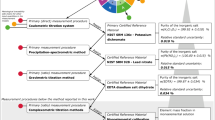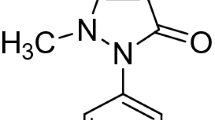Abstract
Binding of bismuth cation with two newly synthesized picolinate containing acyclic (L1) and macrocyclic (L2) ligands was studied. Both ligands demonstrate complex formation with Bi3+ under ambient conditions with high complexation constants. Serum stability of the complexes was investigated in serum protein excess of 10- and 100-times. Experiments with no-carrier-added radiobismuth (207Bi and 213Bi) were performed. A one-column 225Ac/213Bi generator system, based on Ac resin (Triskem Inc.), was tested. The overall yield of 213Bi was exceeding 85% with 225Ac breakthrough below 10−4%.







Similar content being viewed by others
References
Reilly RM (2010) The radiochemistry of monoclonal antibodies and peptides. In: Railly R (ed) Monoclonal antibody and peptide-targeted radiotherapy of cancer, 1st edn. Wiley, New York
McDevitt MR, Sgouros G, Finn RD, Humm JL, Jurcic JG, Larson SM, Scheinberg DA (1998) Radioimmunotherapy with alpha-emitting nuclides. Eur J Nucl Med 25:1341–1351
Morgenstern A, Apostolidis C, Kratochwil C, Sathekge M, Krolicki L, Bruchertseifer F (2018) An overview of targeted alpha therapy with 225Actinium and 213Bismuth. Curr Radiopharm 11:200–208
Ruck M, Locherer F (2015) Reprint of “Coordination chemistry of homoatomic ligands of bismuth, selenium and tellurium”. Coordin Chem Rev 297–298:208–217
Couturier O, Supiot S, Degraef-Mougin M, Faivre-Chauvet A, Carlier T, Chatal JF, Davodeau F, Cherel M (2005) Cancer radioimmunotherapy with alpha-emitting nuclides. Eur J Nucl Med 32:601–614
National Nuclear Data Center, Brookhaven National Laboratory. http://www.nndc.bnl.gov/nudat2/. Accessed 12 Mar 2019
Shannon RD (1976) Revised effective ionic radii and systematic studies of interatomic distances in halides and chalcogenides. Acta Crystallogr A 32:751–767
Spivakov BY, Stoyanov ES, Gribov LA, Zolotov YA (1979) Raman laser spectroscopic studies of bismuth(III) halide complexes in aqueous solutions. J Inorg Nucl Chem 41:453–455
McDevitt MR, Finn RD, Sgouros G, Ma D, Scheinberg DA (1999) An 225Ac/213Bi generator system for therapeutic clinical applications: construction and operation. Appl Radiat Isot 50:895–904
Bray LA, Tingey JM, DesChane JR, Egorov OB, Tenforde TS, Wilbur DS, Hamlin DK, Pathare PM (2000) Development of a unique bismuth (Bi-213) automated generator for use in cancer therapy. Ind Eng Chem Res 39:3189–3194
McAlister DR, Horwitz EP (2009) Automated two column generator systems for medical radionuclides. Appl Radiat Isot 67:1985–1991
Wu C, Brechbiel MW, Gansow OA (1997) An improved generator for the production of 213Bi from 225Ac. Radiochim Acta 79:141–144
Institute for Transuranium Elements, Annual report 2006. ISBN 978-92-79-05001-5
Morgenstern A, Bruchertseifer F, Apostolidis C (2012) Bismuth-213 and actinium-225–generator performance and evolving therapeutic applications of two generator-derived alpha-emitting radioisotopes. Curr Radiopharm 5:221–227
Guseva LI, Dogadkin NN (2009) Development of a tandem generator system 229Th/225Ac/213Bi for repeated production of short-lived α-emitting radionuclides. Radiochemistry 51:169–174
Cooper MS, Ma MT, Sunassee K, Shaw KP, Williams JD, Paul RL, Donnelly PS, Blower PJ (2012) Comparison of 64Cu-complexing bifunctional chelators for radioimmunoconjugation: labeling efficiency, specific activity, and in vitro/in vivo stability. Bioconjugate Chem 23:1029–1039
Camera L, Kinuya S, Garmestani K, Wu C, Brechbiei MW, Pal LH, McMuriy TJ, Gansow OA, Pastan I, Paik CH, Carrasqufflo JA (1994) Evaluation of the serum stability and in vivo biodistribution of CHX-DTPA and other ligands for yttrium labeling of monoclonal antibodies. J Nucl Med 35:882–889
Ruegg CL, Anderson-Berg WT, Brechbiel MW, Mirzadeh S, Gansow OA, Strand M (1990) Improved in vivo stability and tumor targeting of bismuth-labeled antibody. Cancer Res 50:4221–4226
Egorova BV, Matazova EV, Mitrofanov AA, Aleshin GYu, Trigub AL, Zubenko AD, Fedorova OA, Fedorov YuV, Kalmykov SN (2018) Novel pyridine-containing azacrown-ethers for the chelation of therapeutic bismuth radioisotopes: complexation study, radiolabeling, serum stability and biodistribution. Nucl Med Biol 60:1–10
Fedorov YuV, Fedorova OA, Kalmykov SN, Oshchepkov MS, Nelubina YuV, Arkhipov DE, Egorova BV, Zubenko AD (2017) Potentiometric studies of complex formation of amidopyridine macrocycles bearing pendant arms with proton and heavy metal ions in aqueous solution. Polyhedron 124:229–236
Lima LM, Beyler M, Delgado R, Platas-Iglesias C, Tripier R (2015) Investigating the complexation of the Pb2+/Bi3+ pair with dipicolinate cyclen ligands. Inorg Chem 54:7045–7057
Price EW, Zeglis BM, Cawthray JF, Lewis JS, Adam MJ, Orvig C (2014) What a difference a carbon makes: H4octapa vs H4C3octapa, ligands for In-111 and Lu-177 radiochemistry. Inorg Chem 53:10412–10431
Thiele NA, Brown V, Kelly JM, Amor-Coarasa A, Jermilova U, MacMillan SN, Nikolopoulou A, Ponnala S, Ramogida CF, Robertson AKH, Rodriguez-Rodriguez C, Schaffer P, Williams C, Babich JJW, Radchenko V, Wilson JJ (2017) An eighteen-membered macrocyclic ligand for actinium-225 targeted alpha therapy. Angew Chem Int Ed Engl 56:14712–14717
Zhuikov BL, Kalmykov SN, Ermolaev SV, Aliev RA, Kokhanyuk VM (2011) Produce of 225Ac and 223Ra from thorium irradiated with protons. Radiochemistry 53:66–72
Aliev RA, Ermolaev SV, Vasiliev AN, Ostapenko VS, Lapshina EV, Zhuikov BL, Zakharov NV, Pozdeev VV, Kokhanyuk VM, Myasoedov BF, Kalmykov SN (2014) Isolation of medicine-applicable actinium-225 from thorium targets irradiated by medium-energy protons. Solv Extr Ion Exch 32:468–477
Gans P, O’Sullivan B (2000) GLEE, a new computer program for glass electrode calibration. Talanta 51:33–37
Gans P, Sabatini A, Vacca A (1996) Investigation of equilibria in solution. Determination of equilibrium constants with the HYPERQUAD suite of programs. Talanta 43:1739–1753
Hannel TS, Otu EO, Jensen MP (2007) Thermochemistry of the extraction of bismuth (III) with Bis(2-ethylhexyl) phosphoric and 2-ethyhexyl-phenylphosphonic acids. Solvent Extr Ion Exch 25:241–256
Erten HN, Mohammed K, Choppin GR (1994) Variation of stability constants of thorium and uranium oxalate complexes with ionic strength. Radiochim Acta 66(67):123–128
Caceci MS, Choppin GR (1983) The determination of the first hydrolysis constant of Eu(III) and Am(III). Radiochim Acta 33:101–104
Choppin GR, Erten HN, Xia YX (1996) Variation of stability constants of thorium citrate complexes with ionic strength. Radiochim Acta 74:123–127
Fedorov Y, Fedorova O, Peregudov A, Kalmykov S, Egorova B, Arkhipov D, Zubenko A, Oshchepkov M (2016) Complex formation of pyridine-azacrown ether amide macrocycles with proton and heavy metal ions in aqueous solution. J Phys Org Chem 29:244–250
Ruddy FH, Dulloo AR, Seidel JG, Petrović B (2004) Separation of the alpha-emitting radioisotopes actinium-225 and bismuth-213 from thorium-229 using alpha recoil methods. Nucl Instrum Methods Phys Res B 213:351–356
Anderson CJ, Welch MJ (1999) Radiometal-labeled agents (non-technetium) for diagnostic imaging. Chem Rev 99:2219–2234
Ma D, McDevitt MR, Finn RD, Scheinberg DA (2001) Breakthrough of 225Ac and its radionuclide daughters from an 225Ac/213Bi generator: development of new methods, quantitative characterization, and implications for clinical use. Appl Radiat Isot 55:667–678
Price EW, Cawthray JF, Bailey GA, Ferreira CL, Boros E, Adam MJ, Orvig C (2012) H4 octapa: an acyclic chelator for 111 in radiopharmaceuticals. J Am Chem Soc 134:8670–8683
Song HA, Kang CS, Baidoo KE, Milenic DE, Chen Y, Dai A, Brechbiel MW, Chong HS (2011) Efficient bifunctional decadentate ligand 3p-C-DEPA for targeted alpha-radioimmunotherapy applications. Bioconjugate Chem 22:1128–1135
Jaraquemada-Peláez MDG, Wang X, Clough TJ, Cao Y, Choudhary N, Emler K, Patrick BO, Orvig C (2017) H4 octapa: synthesis, solution equilibria and complexes with useful radiopharmaceutical metal ions. Dalton Trans 46:14647–14658
Kang CS, Song HA, Milenic DE, Baidoo KE, Brechbiel MW, Chong HS (2013) Preclinical evaluation of NETA-based bifunctional ligand for radioimmunotherapy applications using 212Bi and 213Bi: radiolabeling, serum stability, and biodistribution and tumor uptake studies. Nucl Med Biol 40:600–605
Milenic DE, Roselli M, Mirzadeh S, Pippin CG, Gansow OA, Colcher D, Brechbiel MW, Schlom J (2001) In vivo evaluation of bismuth-labeled monoclonal antibody comparing DTPA-derived bifunctional chelates. Cancer Biother Radio 16:133–146
Nikula TK, McDevitt MR, Finn RD, Wu C, Kozak RW, Garmestani K, Brechbiel MW, Curcio MJ, Pippin CG, Tiffany-Jones L, Geerlings MWS, Apostolidis C, Molinet R, Geerlings MWJ, Gansow OA, Scheinberg DA (1999) Alpha-emitting bismuth cyclohexylbenzyl DTPA constructs of recombinant humanized anti-CD33 antibodies: pharmacokinetics, bioactivity, toxicity and chemistry. J Nucl Med 40:166–176
Wadas TJ, Wong EH, Weisman GR, Anderson CJ (2010) Coordinating radiometals of copper, gallium, indium, yttrium, and zirconium for PET and SPECT imaging of disease. Chem Rev 110:2858–2902
Casassas E, Fonrodona G (1988) Potentiometric study of the protonation and binary complexation equilibria between the hydrogen ion, copper (II) ion and zinc (II) ion and the picolinate ion in dioxane-water mixtures. Polyhedron 7:689–694
Thakur P, Conca JL, Dodge CJ, Francis AJ, Choppin GR (2013) Complexation thermodynamics and structural studies of trivalent actinide and lanthanide complexes with DTPA, MS-325 and HMDTPA. Radiochim Acta 101:221–232
Acknowledgements
This work has been supported by the Russian Science Foundation under Contract № 17-73-10465 (225Ac producing and 225Ac/213Bi generator developing) and Russian Foundation for Basic Research Contract № 18-33-20152 (synthesis of ligands and complexation study).
Author information
Authors and Affiliations
Corresponding author
Additional information
Publisher's Note
Springer Nature remains neutral with regard to jurisdictional claims in published maps and institutional affiliations.
Electronic supplementary material
Below is the link to the electronic supplementary material.
Rights and permissions
About this article
Cite this article
Sinenko, I.L., Kalmykova, T.P., Likhosherstova, D.V. et al. 213Bi production and complexation with new picolinate containing ligands. J Radioanal Nucl Chem 321, 531–540 (2019). https://doi.org/10.1007/s10967-019-06610-w
Received:
Published:
Issue Date:
DOI: https://doi.org/10.1007/s10967-019-06610-w




